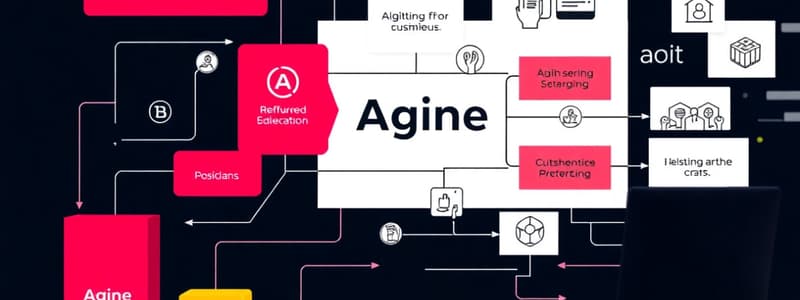Podcast
Questions and Answers
Briefly describe the primary goal of the 'Requirements Process' in software engineering.
Briefly describe the primary goal of the 'Requirements Process' in software engineering.
The primary goal is to fully specify the customer's requirements for the software, ensuring everyone understands what the software should do.
List three core components typically addressed within 'Software Processes'.
List three core components typically addressed within 'Software Processes'.
People, Processes, and Technology.
Explain how 'Timeboxing' is implemented and its main advantage in software development projects.
Explain how 'Timeboxing' is implemented and its main advantage in software development projects.
Timeboxing involves fixing the delivery date and budget while allowing the feature set to vary. Its main advantage is ensuring a regular delivery schedule and managing scope creep.
Describe a scenario where using 'Waterfall Model' would be most appropriate, and outline one significant limitation in using it.
Describe a scenario where using 'Waterfall Model' would be most appropriate, and outline one significant limitation in using it.
Imagine a project where the initial requirements are vague, and the client requires frequent demonstrations of working functionality. Which software development process model(s) would be most suitable, and why? Conversely which would definitely NOT be suitable and why?
Imagine a project where the initial requirements are vague, and the client requires frequent demonstrations of working functionality. Which software development process model(s) would be most suitable, and why? Conversely which would definitely NOT be suitable and why?
Name the four fundamental activities common to all software processes.
Name the four fundamental activities common to all software processes.
Explain the main difference between the Waterfall model and Iterative development.
Explain the main difference between the Waterfall model and Iterative development.
What is the primary goal of Timeboxing in software development?
What is the primary goal of Timeboxing in software development?
In the context of software project management, how do 'scale' and 'change' introduce challenges to software processes, and what adjustments might be necessary?
In the context of software project management, how do 'scale' and 'change' introduce challenges to software processes, and what adjustments might be necessary?
Imagine a scenario where a software development team is using Extreme Programming (XP), but encounters significant difficulty in maintaining pair programming due to team members being located across different time zones. Propose a modified approach consistent with agile principles that addresses this challenge while still emphasizing collaboration and code quality. Detail the specific practices and tools you would implement.
Imagine a scenario where a software development team is using Extreme Programming (XP), but encounters significant difficulty in maintaining pair programming due to team members being located across different time zones. Propose a modified approach consistent with agile principles that addresses this challenge while still emphasizing collaboration and code quality. Detail the specific practices and tools you would implement.
Flashcards
Software Process
Software Process
A structured set of activities to develop and evolve software.
Waterfall Model
Waterfall Model
A sequential design process, where each stage must be completed before the next begins.
Software Specification
Software Specification
Specifying what the system should do.
Software Development
Software Development
Signup and view all the flashcards
Software Evolution
Software Evolution
Signup and view all the flashcards
What is a software process?
What is a software process?
Signup and view all the flashcards
Fundamental Activities
Fundamental Activities
Signup and view all the flashcards
Software Design
Software Design
Signup and view all the flashcards
Software Validation
Software Validation
Signup and view all the flashcards
Study Notes
- Chapters 2 and 3 address software engineering processes and agile development.
- Chapter 2 introduces software process models, like the waterfall model, and discusses the basic activities of these processes.
- A software process involves a sequence of activities that leads to the production of a software product.
- Four fundamental activities are common to all software processes: software specification, software development, software validation, and software evolution.
- These chapters support a one-semester introductory course in software engineering.
- Important concepts include software processes and agile methods.
- Essential software development activities, from requirements specification through system evolution are described.
Software Engineering
- Software engineering is an engineering discipline concerned with all aspects of software production.
- This extends from the early stages of system specification through to maintaining the system after use.
Studying That Suits You
Use AI to generate personalized quizzes and flashcards to suit your learning preferences.
Related Documents
Description
Explore software engineering processes and agile development. Software processes include specification, development, validation, and evolution. These activities support an introductory course in software engineering, emphasizing processes and agile methods.




